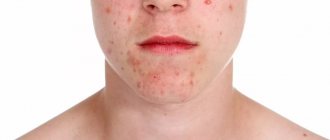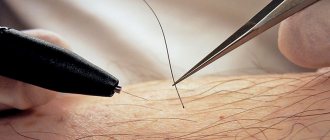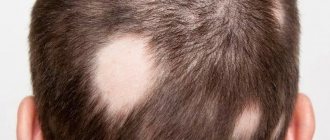Every person wants to preserve their natural beauty for as long as possible, but what to do if nature deprived you of something and your appearance turned out to be completely different from what you would like? Unfortunately, this can happen for various reasons, but in this case there is referring to such a phenomenon as hypertrichosis or simply: increased body hair. What kind of disease this is, how it manifests itself and how to deal with it, you will find out by reading our article to the end.
Hypertrichosis syndrome
- Hypertrichosis is a disease that is also called Ambras syndrome , and it is expressed in an excessive amount of hair on the surface of the human body.
- Hypertrichosis can affect a large surface of the body, including the face, legs, arms, or be localized in a separate area - all this depends on the reasons that caused the disease.
- Hypertrichosis is either inherited (it is called congenital), or acquired during life for various reasons, which will be discussed below.
- The disease can manifest itself to a severe degree - in this case, abnormal phenomena can also affect the jaws , when the child either erupts teeth late, or they never erupt at all. Fortunately, this degree of severity of the disease is extremely rare, and doctors and scientists have still not been able to figure out which genetic defects cause such mutations.
- The hair that covers the body, face or limbs, depending on where exactly it grows, has different density, color and thickness, and the degree of its hardness and the speed at which it grows vary.
Excessive hair growth
Signs of hypertrichosis
- The clinical manifestations of the disease hypertrichosis are excessive hair on the body, as well as on the face, and, equally, this phenomenon can be characteristic of both representatives of the strong and weak half of humanity.
- If hypertrichosis is congenital, then hair covers the entire human body, excluding the feet and palms. Hair growth is especially pronounced in the area of the face, shoulders, and very often - hypertrichosis of the auricle. Hair can grow tens of centimeters long (this applies to the face area).
Hair growth
- With vellus hypertrichosis in infants, the covering of the body with light hairs is clearly visible, excluding the limbs. Then the hair falls out (this happens around the age of one year), but hair growth begins on the limbs.
- There is also focal hypertrichosis, in which black, coarse hair grows in certain areas of the body affected by some pathology.
- Expressed in the prepubertal period, hypertrichosis is expressed by hair growth in the temple area , from where it spreads to the forehead. The presence of thick eyebrows, long dark hair on the upper back, arms and legs - these are the signs of this type of hypertrichosis.
- Hypertrichosis can be acquired as a result of taking certain medications, and depending on the type of drug, it affects the limbs and facial area. With secondary hypertrichosis (acquired as a result of diseases such as hepatic porphyria, anorexia, celiac disease, juvenile dermatomyositis, oncology, AIDS, etc.), excessive hair growth on the face, body and limbs may also occur.
- Thus, a sign of hypertrichosis is excessive hair growth in areas of the body that are characterized only by the growth of vellus hair.
Causes and risk factors
Despite the fact that hypertrichosis is not considered a very common disease, the causes of its manifestation are of interest to many people. Contrary to popular belief, this rather interesting phenomenon is not a consequence of pathology, when a very high content of male hormones is found in the blood, affecting increased hair growth in androgenic areas, but has other reasons, since it can be observed on any part of the body.
Among the known causes of the disease today are:
- genetic pathologies , including abnormalities of the central nervous system and skeletal system due to viral diseases suffered by the mother in the initial stages of pregnancy (in this case, hypertrichosis is one of the symptoms);
- spinal dysraphism is a congenital disorder that occurs due to impaired development of the fetal neural tube during intrauterine life (more often manifested by the appearance of an excessive amount of hair on the lower back);
- neurofibromatosis - characterized by the appearance of uncharacteristic long hairs in the chest area and is a serious hereditary disease;
- problems with metabolic processes and hormone imbalance , which are often associated with certain periods of a person’s life (for example, changes in the body of adolescents), a woman carrying a baby or problems with the endocrine glands (for example, hypothyroidism, hyperthyroidism, malignant neoplasms of the adrenal glands, thyroid gland, ovaries);
- neoplasms in the brain and mammary glands;
- serious mental disorders and psycho-emotional disorders (among the most common is epilepsy);
- formation of scars on the skin in places of injury and constant mechanical impact on the same area of the body (blood flow accelerates in this place, which is why stimulation of hair follicles is observed);
- premature puberty.
In addition, increased hair formation can also be affected by constant cosmetic and therapeutic procedures that help increase blood flow to the hair follicles: for example, paraffin therapy, pepper patches, mustard plasters, the use of ointments with glucocorticosteroids, long-term massages, cryotherapy, etc. You should avoid and any hair removal procedures, especially on the face.
Based on the specific cause of hypertrichosis, one can judge its form: congenital or acquired.
Important!
When assessing the condition of a person with a high level of hair growth, one should also take into account such a factor as nationality, because what would be the norm for some peoples, for representatives of others, will most likely turn out to be manifestations of hypertrichosis (for example, excessive hair formation is typical for residents Caucasus, Israel and citizens of Arab states, while for Europeans this is already a pathology).
Gene for hypertrichosis in humans
- Hypertrichosis is characteristic mainly of men , transmitted via the Y chromosome in conjunction with sex. If we talk about congenital generalized hypertrichosis, it is a fairly rare disease of autosomal dominant etiology.
- His discovery dates back to the 16th century and the cause was identified as a mutation on chromosome 8, which is also called pericentric inversion. The disease can be transmitted both to each next generation and across generations.
- There is also a version that speaks of X-linked inheritance of the disease, since medicine has described a case of a father transmitting a mutant gene only to his daughters, while none of the sons became a carrier of the disease. Also, the reasons for the manifestation of congenital vellus hypertrichosis are not fully understood, since the main version put forward by researchers speaks of an autosomal dominant pathway by which the disease is transmitted, but, as in any rule, there are exceptions: there are certain cases of the disease that contradict the main version.
- No pathologies of genetic origin were identified, as well as changes in the endocrine system. It has only been established that congenital hypertrichosis can manifest itself if either one of the parents or both are susceptible to it.
Cause of the disease
What are the types of hypertrichosis?
- Hypertrichosis has several types - depending on the time of appearance, a distinction is made between congenital and acquired disease.
- From the scale of hair coverage of areas of the body - focal, covering local areas, and generalized, which spreads over a large surface of the body.
- There are also differences in which area is affected - elbows, neck, ears, spine , etc.
- Another division into species depends on how the disease appeared. Either for no obvious reason, or it arose against the background of another pathological condition.
As for acquired hypertrichosis, it can also be generalized, and in turn is divided into the following types according to etiology:
- Medicinal , provoked by taking certain medications.
- Secondary , which appears as a consequence of another disease that acts as a background for the development of hypertrichosis.
- Pushkovy , the background for which is usually cancer.
- Focal , occurring in places of constant friction or compression, or in the presence of inflammation that has become chronic (as a rule, in such cases, hair can be removed quite easily by regular shaving or epilation).
- Traumatic , which manifests itself as a result of injury or burn, as well as on the face as a result of constantly plucking hairs, or due to poor shaving - as a result, hair follicles are activated, and in place of thin and light vellus hair, terminal hairs actively grow, which are much more harder and darker.
In the case of local hypertrichosis, hair growth affects certain individual areas of the body. The main types of hypertrichosis, classified according to location.
So, if hypertrichosis is localized in:
- The chest area, which is also covered with hair, like fur.
- On the lower back – here, as a rule, long black hair grows, which resembles a bun; by the way, it is called a faun’s bun.
- A nevus is a kind of “birthmark” from which dark, coarse hair grows. It can be localized on almost any part of the body.
Local
In addition, in both men and women, hypertrichosis can affect the face and ears. And one more thing, with hypertrichosis there is excessive hair growth even in ordinary places, for example, on the pubis or in the armpits, and this is typical for representatives of both sexes.
Classification
Hypertrichosis can be acquired in only two main ways: being born with it or getting it during life due to certain factors. At the same time, many experts consider the latter option not so scary, since getting rid of it is much easier than getting rid of a congenital pathology.
Congenital
If a child is born with increased hair growth, then most likely there has been a genetic mutation that has caused a change in the epithelial cells, which increasingly acquire the characteristics of the epidermis.
This usually happens due to infectious diseases that a woman suffers in the initial stages of pregnancy, the development of gestosis or the threat of premature termination. There are also cases when, in the absence of obvious signs of hypertrichosis, the baby is a carrier of a damaged gene and is able to pass it on to his descendants.
Today, there are many forms of congenital hereditary disease, noticeable already at the birth of a baby: for example, hair growth can be universal or germinal, which further progresses greatly in the puberty period and remains with the person until the end of his life.
In most cases, in such babies, at first the junction of the hair and eyebrows is clearly visible, but with further development, during the neonatal period and early childhood, the area of hair growth increases, with the only exceptions being the palms and feet. The length of soft vellus hairs can easily reach ten centimeters.
In some cases, the congenital form of the disease is not immediately noticeable, but only after 2-7 years of the baby’s life. Thick, thin, long, pigmented hair begins to grow at an incredible speed, in some situations combined with edentia (lack of tooth growth), dystrophy, central nervous system problems and other defects.
True, variants of an isolated form are quite possible, when the disease is not associated with other anomalies and manifests itself only at puberty or in the involutionary period.
Among the congenital forms of the described disease, it is worth highlighting the local form, which is expressed in the appearance of strongly curly long hairs of different colors on the pigmented part of the body: a birthmark with hairs or a “faun's tuft” in the sacral area (the result of a pathological condition of the sacral area of the spine).
Important!
The risk of a congenital form increases if the disease has already occurred in someone in the family (if after one generation, then the risk of development in the future baby is 50%). The disease can be transmitted from any parent.
Acquired
As the name suggests, unlike the congenital form of hypertrichosis, its acquired version appears at any time in a person’s life and has no genetic explanation. The main subtypes of this disease are:
- Acquired hypertrichosis of the vellus type , when the germinal hair can reach a length of 15 cm in just two to three months (increased hair growth is noticeable first on the facial part, and then the growth of hairs is noticeable throughout the body, leaving only the palms and feet untouched). In almost 100% of situations, it is this kind of hypertrichosis that acts as an early evidence of the development of neoplasms in the lungs, urinary or gall bladders, and uterus.
- Acquired disease of a traumatic nature - appears in the area of injury, on scars, places of damage to peripheral nerves (usually combined with hyperhidrosis), or at points of prolonged exposure to pepper plasters, plaster casts, ointments and other similar cosmetics and medicines (for women one of the most common reasons include hair removal, depilation, paraffin therapy and mud applications).
- Drug-induced hypertrichosis is a consequence of the use of certain external medications: for example, Psoriazin, ointments based on glucocorticosteroids, Antipsoriaticum, Danazol, Minoxidil, Cyclosporine and some other medications that stimulate hair growth. Sometimes increased hair growth is the result of the use of androgenic, anabolic and anti-tuberculosis drugs.
- Neurogenic hypertrichosis is explained by a negative effect on the peripheral nerve or any part of the spinal cord.
- The symptomatic variety occurs as a sign of tuberculosis (in children it is often noticeable between the shoulder blades), malignant neoplasms in the brain, certain chromosomal ailments, diabetes mellitus, some mental illnesses in women (hair grows mainly under the nose or on the chin), hypothalamic pituitary syndrome and other ailments. Sometimes symptomatic hypertrichosis actively progresses with neurofibromatosis and dermatomyositis.
To eliminate any of these problems, you first need to get rid of its specific cause. In some cases, this is easier to do, in others it is somewhat more difficult, but if you want to feel good and look great, then treatment is simply necessary.
Causes of hypertrichosis
The causes of the disease are mainly associated with the types of hypertrichosis listed above, since they are the basis for classification.
Thus, hypertrichosis can be caused by such reasons as:
- A congenital mutation that developed as a result of a problematic pregnancy or an infectious disease suffered by the expectant mother during the first trimester of pregnancy.
- Taking certain medications.
- Disturbances in the functioning of the thyroid gland and the endocrine system as a whole.
- Certain conditions or diseases that cause symptomatic hypertrichosis, for example, alcoholism, nervous exhaustion, traumatic brain injury, etc.
- Damage to the skin due to injury or burn.
- Hair follicles may increase their growth as a result of the development of a malignant tumor.
And, of course, the cause of congenital hypertrichosis is a gene mutation that affects successive generations.
Hypertrichosis in men
- The most common places for hair growth in men are the back, shoulders and arms ; hair covering the ears is also common. Experts consider such abundant hair growth to be a kind of atavism, and most often it manifests itself already at the birth of a boy.
- The causes of hypertrichosis in men are almost all of the above, and in this regard it is essentially no different from women. The only thing that affects the intensity of the disease is a greater amount of male hormones in the body, as opposed to female ones. This greatly promotes abundant hair growth and distribution throughout the body and face while preventing hair growth on the scalp.
- Also, in men, the phenomenon of fused eyebrows is much more common , which is one of the localizations of hypertrichosis, which in such a case is called limited.
- And, above all, men more often become victims of traumatic hypertrichosis due to constant shaving, which can cause skin irritations.
In men
Diagnostics
Hypertrichosis is not always an independent disease, therefore, in order to get rid of its unpleasant manifestations, you will first have to conduct a comprehensive diagnosis of all organs and systems of your body.
Examination by a doctor
The first specialists to visit in case of increased hair growth are a dermatologist, endocrinologist and gynecologist, because it is their diagnostic methods that most often help determine the problem of excessive hair growth.
Each of the doctors will conduct a full examination and give their opinion, after which it will be possible to judge the nature of everything that is happening.
If none of them finds traces of hormonal imbalance, then treatment of hypertrichosis will be carried out only by hair removal. Important!
Attempts to independently solve the problem can lead to its aggravation, because not all methods of removing unwanted vegetation can be used in each specific case. A cosmetologist will tell you what is best to choose.
Analyzes
The first and main task to confirm or refute the diagnosis of “hypertrichosis” is to check the level of male hormones in the blood, for which, in fact, a biochemical blood test is performed. Its results also give an idea of the level of the prevailing pathological process: in the presence of congenital hypertrichosis, already from this study it is possible to draw conclusions about the developing disease of an endocrine nature. Of course, having dealt with it, you will also solve the problem of increased hair growth.
In addition, a clinical blood test is required and hair samples are analyzed to determine their mineral composition.
Surveys
Each of the above-mentioned specialists can prescribe their own specialized examinations. This can be an ultrasound of the pelvic organs (in women) and the thyroid gland, CT, MRI of the brain and even x-rays. The main task of doctors, especially if there is no increased level of androgens in the blood, is to exclude the possible development of oncology and other serious problems, since many of them have symptoms similar to hypertrichosis.
Hypertrichosis in women
- Hypertrichosis in women, largely coinciding with men's, has a localization , namely, they begin to grow a mustache or beard, which in principle is not inherent in women, in whose body female hormones normally predominate, which promote hair growth. not on the face or body, but on the head.
- In addition, a type of hair growth characteristic of men is possible, when pubic hair does not grow in a triangle, as usual, but takes on a diamond shape. More often in this case they talk about hirsutism , but hypertrichosis can also be expressed in this way.
- The most common locations for hypertrichosis in women are the nasolabial folds and chin, arms, chest, and genitals . The disease can manifest itself at any age, both in youth and during menopause against the background of hormonal changes in the body.
- Methods used by women also contribute to hair strengthening and abundant growth: depilation, shaving, plucking individual hairs.
Happens also in women
Hypertrichosis in a child
- The first hair that appears on a baby while still in the womb is called lanugo and is essentially the original down, which usually falls out by the 36th week of fetal development, but if the birth is premature, then the down may be present on the newborn.
- Then the body is covered with vellus hair, thin and light, practically without pigment. And especially hard, thicker than usual, and dark-colored hair is called core hair.
- So, if a child is born covered with lanugo hair, then, as a rule, they fall out over time, but their patchy growth due to certain malformations, and then careful examination and treatment are required.
- A child who is developing and growing rapidly may develop hair on the forearms and lower legs , which is not a pathology. Representatives of some nationalities may actively grow shaft hair (for example, Gypsies, Jews or Caucasians) - this is also considered the norm.
- It is important to determine the cause of premature hair growth in girls in those places that are characteristic of the action of sex hormones, such as the pubic area, inner thighs, armpits, abdomen and chest .
- Then a parallel examination by both an endocrinologist and a gynecologist is necessary to determine whether this fact is the result of hypertrichosis, or caused by disorders in the endocrine system.
- And, of course, it is important to determine whether hair growth is a consequence of taking glucocorticoids and other drugs. If the cause of hypertrichosis in children is not determined by external factors, doctors talk about idiopathic hair growth , which is determined by the Ferrimon-Gallwey scale, which evaluates hair growth in a particular area of the face or body using a four-point system.
- If the number of points exceeds 7, they speak of hormonal disorders.
Hypertrichosis in children
How and on what parts of the body does it manifest itself?
Despite the similarity of the problem among representatives of different sexes and ages, the manifestations of hypertrichosis still have their differences. Let's find out which ones exactly.
Among women
If there is a problem of increased hair growth in women, excessive hair growth is usually observed on the chin, in the area of the nasolabial folds, décolleté, genitals and over the entire surface of the limbs. By the way, in the so-called “bikini zone”, the area of hair growth expands according to the male type.
Local varieties of hypertrichosis in the fairer sex include, for example, a problem localized in different parts of the sternum, and the same prothoracic variant may not be an independent disease, but only a symptom of another disease (often neurofibromatosis, combined with depressed sternum).
Local lumbar manifestation of hypertrichosis is sometimes associated with spinal dysraphism, that is, non-fusion of the spinal column. With such a problem, a tuft of soft and long hair will be present in the affected area.
Typically, the female version of hypertrichosis is accompanied by other neurological symptoms, such as weakness in the limbs, sphincter insufficiency and loss of sensitivity. You can get rid of most of these problems only through surgery.
With increased facial hair, the eyebrow area is usually affected (they grow together), and this problem is often observed in several members of the same family.
The local version of female hypertrichosis, as well as male hypertrichosis, involves the presence of congenital malformations and manifests itself in fairly large hairy birthmarks called nevi.
In some cases they are covered with colorless vellus hairs, and in others - dark and coarse. Did you know?
Astrologers believe that the location of moles and birthmarks on the body can tell a lot about the fate and character of their owners. For example, a mole on the cheek indicates a friendly and hardworking person, while a similar mark on the nose would be considered a sign of hot temper and passion.
In men
Male hypertrichosis accounts for about 14% of the total number of cases of this deviation. Usually it is expressed in increased hair growth in areas with standard, male hair growth, but in this case there is a lot of hair. Thus, the disease often manifests itself on the back, shoulder area, legs and is considered a sign of atavism, accompanying boys from the maternity hospital. However, as in the case of the female sex, options for total hair growth are possible.
In children
In childhood, hypertrichosis is usually associated with nevi and is a congenital pathology (pronounced signs of the disease throughout the body are rare: approximately in one case per billion births).
In such children, the entire vellus cover, which normally should have disappeared during the prenatal period, does not disappear anywhere and is clearly visible in the first minutes of the baby’s life. However, if slight pubescence can still disappear in the next few weeks of the baby’s life, then abnormally hard, dark and densely growing hairs remain with the child for many years.
If the baby does not have problems with the endocrine system and there are no signs of malignant or benign neoplasms, then hypertrichosis does not threaten anything, being only an aesthetic problem.
Did you know?
Before the end of puberty, correction of the disease in children is carried out by bleaching the hair with a three percent solution of hydrogen peroxide, or removing the hair with special creams.
Hypertrichosis of the ears
- This localization of the disease is typical for both women and men. It can also be hereditary or acquired under the influence of external factors or other pathologies. The most common causes of ear hypertrichosis, in addition to a hereditary factor determined by a gene mutation, is the transformation of epithelial tissue into cells that contain hair follicles.
- In addition, there are a number of other common causes for hypertrichosis - injuries, surgical interventions, malignant neoplasms, pathological conditions during pregnancy, taking medications, mechanical.
- Usually, if there is little hair, more thorough ear hygiene is sufficient, but if there is too much hair and it continues to grow rapidly, a doctor’s intervention is necessary.
It also happens in the ears.
Signs of incipient hypertrichosis of the auricle are the following:
- The hair in the ear area becomes thicker.
- Coarse hairs appear in the middle of the ear.
- The hair growth area increases.
- The person begins to experience discomfort.
- It is also necessary to carefully monitor if the baby was born with small stubble on the ear, whether it fell out during the first few months after birth. If not, you need to see a doctor.
- In addition, age also plays an important role - the older the person, the greater the risk of ear growth . To determine the reason for the activation of the follicles, it is necessary to examine not only the hairy areas, but also the condition of the body in general.
- Among the methods that can be used to combat the problem, if it is minor, is cutting the hairs and removing them with tweezers . These are not the most reliable methods, since they can lead to both mechanical damage to the ear itself and transformation of the hairs into harder ones. Photo and laser hair removal methods do a better job of removing hair
- The first is carried out exclusively on dark hair and is quite long-lasting, the second affects the hair follicles and can solve the problem radically. Treatment with hormonal drugs is also possible which is carried out exclusively with a doctor’s prescription and under his constant supervision.
How is it different from hirsutism?
Many people consider hirsutism and hypertrichosis to be almost identical concepts, however, if you analyze the features and places where hair appears, the difference will be obvious.
The first disease is diagnosed exclusively in females, while the second is typical for both sexes at any age. In addition, hirsutism is manifested only by hair growth in usually male areas (face, chest, abdomen, back, nipple area, etc.), but hypertrichosis is not excluded in other areas.
Did you know?
The second name of the disease is “werewolf syndrome,” and if in our time people are more confused by the aesthetic nature of the problem, then in the Middle Ages women and men with this disease were recognized as messengers of the devil and sentenced to death.
Treatment of hypertrichosis
- Like any treatment, the fight against hypertrichosis is aimed primarily at eliminating the cause of the disease. Therefore, treatment methods vary.
- So, if hypertrichosis is caused by disturbances in the functioning of the endocrine system, then the underlying disease is treated first. If the treatment is carried out on the basis of taking hormonal drugs, then in the case of hypertrichosis developing under their influence, the drug is replaced by its analogue.
- Before starting treatment, consultation with specialists such as an endocrinologist and dermatologist , and women should also be required to visit a gynecologist.
- laser and photoepilation , the use of chemical depilatory agents, and exposure to intense pulsed light remain some of the most effective methods for treating hypertrichosis Among medications, doctors highlight eflornithine, which is involved in the process of hair growth.
Limited
Diseases associated with excess hair growth include hirsutism, which is often confused with hypertrichosis. You should know that the first disease is characteristic only of women, and it is manifested by hair growth characteristic of the male type. The second disease, hypertrichosis, can occur in both men and women, and at any age.
Possible complications
If the root cause of increased hair growth is not any cancer or other serious illnesses, then the main complications include problems of a psychological nature, expressed in low self-esteem and difficulty building social relationships.
Typically, children and adolescents suffer the most from psychological discomfort, although depression associated with the current condition cannot be ruled out in adulthood.
If the development of hypertrichosis is based on some endocrine or gynecological problem, then, in addition to psychological issues, a worsening of a person’s physical condition is possible, up to the appearance of infertility, problems with excess weight (often explained by hormonal imbalances), etc.
Family with hypertrichosis
- The best known familial case of hypertrichosis are members of the Gonsalvus family , which lived in the 16th century. His father, Petrus Gonsalvus, was perceived as a monkey-man from childhood and it was in this capacity that he was taken as a servant to the French king Henry II at the age of 10. He married an ordinary woman who was not susceptible to hypertrichosis, but of the seven children born in this marriage, four also inherited the disease.
- Their portraits were painted by artists of that time; the best minds of France and Italy argued about the causes of the disease and its heredity.
- Another family is the Aceves, who currently live in Mexico. The most famous is Jesus, commonly called Chewie. He, like his sister and cousins, were born with hypertrichosis. Chui himself became the father of three daughters, who were born to different women, and at the same time, all the girls inherited their father's disease.
Family
- This chain began with Jesus’ great-grandmother, and during this time, 30 members of the Aceves family were born and live with a similar diagnosis. A film was made about the family - and this is not surprising, because out of 50 people who have had hypertrichosis recorded in the entire history of registration of cases of the disease, 30 are members of the Aceves family.
From our articles you will learn about the syndrome:
- Life deferred
- Excellent student
- Carpal tunnel syndrome
- Tourette's
- Morris







